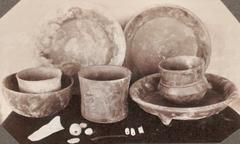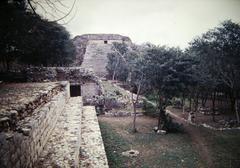Chichen Itza Visiting Hours, Tickets, and Comprehensive Guide to Yucatán’s Historical Treasure
Date: 14/06/2025
Introduction
Chichen Itza, nestled in Mexico’s Yucatán Peninsula, stands as a testament to the ingenuity and spirituality of the ancient Maya civilization. Recognized as a UNESCO World Heritage Site and one of the New Seven Wonders of the World, it draws millions of visitors each year who marvel at its architectural wonders and immerse themselves in its rich cultural heritage. From the awe-inspiring Pyramid of Kukulkan to the mysterious Sacred Cenote, Chichen Itza offers a captivating journey into the past.
This detailed guide provides everything you need for an enriching and responsible visit: historical context, visiting hours, ticketing information, travel logistics, accessibility, guided tour recommendations, conservation updates, and practical tips for making the most of your experience (World History Encyclopedia; Mexico Historico; Traveling with Aga).
Contents
- Historical Development of Chichen Itza
- Origins and Early Settlement
- Rise to Prominence
- Decline and Abandonment
- Architectural and Scientific Achievements
- Cultural and Spiritual Significance
- Visiting Chichen Itza: Essential Information
- Conservation Efforts and Responsible Tourism
- Frequently Asked Questions (FAQs)
- Conclusion and Recommendations
- Sources
Historical Development of Chichen Itza
Origins and Early Settlement
Chichen Itza, meaning “the city next to the well of the Itzáes,” was established around the 6th century CE, though the area was revered long before due to its proximity to cenotes—natural sinkholes significant for both water supply and ritual purposes (Tren Maya; World Atlas). The Sacred Cenote, in particular, played a central role in Maya cosmology and religious practice.
Rise to Prominence
Between 750 and 1200 CE, Chichen Itza became a major regional power, serving as a political, economic, and religious hub. Its rise saw the construction of monumental architecture, blending Maya traditions with Toltec influences—reflected in the militaristic iconography and the introduction of feathered serpent motifs, especially evident in the Temple of the Warriors and the Platform of the Skulls (World History Encyclopedia; Mexico Historico).
Decline and Abandonment
By the late 12th century, Chichen Itza’s dominance waned, partly due to internal strife and the emergence of Mayapán as the new capital. Significant buildings suffered damage during revolts, and by the time of Spanish arrival in the 16th century, the city was largely abandoned, though it remained spiritually significant to the Maya (World Atlas; World History Encyclopedia).
Architectural and Scientific Achievements
Chichen Itza’s architectural marvels showcase advanced knowledge in engineering, mathematics, and astronomy:
- El Castillo (Pyramid of Kukulkan): Standing about 30 meters tall, this pyramid is aligned with celestial events. Each of its 365 steps represents a day of the solar year. During equinoxes, shadows create the illusion of a serpent descending the staircase (Mexico Tours; Mexico Historico).
- The Great Ball Court: The largest in Mesoamerica, this court was used for ritual games with significant religious undertones (World Atlas).
- Temple of the Warriors & Group of a Thousand Columns: This complex exemplifies Toltec influence, with columns depicting warriors and ceremonial scenes (World History Encyclopedia; Blog Xcaret).
- El Caracol (The Observatory): A circular structure with windows aligned to astronomical events, illustrating the Maya’s sophisticated understanding of the cosmos (The Tourist Checklist; Blog Xcaret).
- Sacred Cenote: Used for offerings and sacrifices, it underlines the spiritual connection between the Maya and natural elements (Drive Mexico Magazine; EverySteph).
- Other Notable Structures: The Tzompantli (Skull Platform), Temple of the Jaguars, Nunnery Complex, Akab Dzib, and various platforms further illustrate the city’s complexity and ritual life (PlanetWare).
Cultural and Spiritual Significance
Chichen Itza was a center for religious ceremonies, education, and cultural exchange. Its temples and plazas were sites of rituals intended to ensure cosmic harmony and communicate with deities. The architecture reflects a worldview where the cosmos, earth, and underworld were interconnected, with features like the Sacred Cenote serving as portals to the divine (Drive Mexico Magazine; World Atlas).
Today, Chichen Itza remains a source of pride for the Yucatán region, symbolizing indigenous resilience and cultural continuity. Its recognition as a UNESCO World Heritage Site and as one of the New Seven Wonders of the World underscores its global importance (Mexico Historico).
Visiting Chichen Itza: Essential Information
Opening Hours
- Open daily from 8:00 AM to 5:00 PM; last entry at 4:30 PM (A Piece of Travel).
- Early arrival is advised to avoid heat and crowds.
Tickets and Admission
- General admission for foreign visitors: approximately 533–648 MXN (about $27–$35 USD). Mexican nationals pay reduced fees or enter free on Sundays (Traveling with Aga).
- Payment: Some fees must be paid in cash; credit cards accepted for general admission.
- Tickets can be purchased at the entrance or via reputable third-party platforms; online advance purchase recommended in high season.
How to Get There
- By Car: Located about 120 km east of Mérida and 200 km west of Cancún. Main highways are well-maintained, with parking available (120 MXN/day).
- By Bus: ADO offers direct routes from Cancún, Mérida, and Valladolid. Buy tickets online, or in person if international cards aren’t accepted (Traveling with Aga).
- Group Tours: Convenient options including transportation, guides, and stops at cenotes or Valladolid.
- Colectivo: Shared vans for budget travelers from nearby towns.
Accessibility
- Paved and flat main paths enhance accessibility, though uneven terrain and steps remain in some areas.
- Wheelchair-accessible parking and restrooms are available; specialized tours can be arranged (A Piece of Travel).
- Climbing pyramids is prohibited for all visitors.
Guided Tours
- Certified guides available at entrance or bookable in advance; tours cost 600–1000 MXN per group.
- Private tours offer flexibility and in-depth insights.
- Tours in English, Spanish, and other languages are available (Chichen Itza Tour Guide).
On-Site Facilities
- Restrooms and shops at entrance; limited facilities inside.
- Vendors sell snacks, water, hats, and local crafts.
- Nearby hotels offer accommodation and amenities, though some perks (e.g., private entrances) may be suspended.
Nearby Attractions
- Cenotes: Ik Kil and Sagrado for swimming and relaxation.
- Valladolid: A colonial town ideal for combining with your Chichen Itza visit.
- Ek Balam: Another impressive archaeological site close by.
Special Events and Photo Tips
- Equinox Events: Crowds gather to witness the serpent shadow on El Castillo during spring and autumn equinoxes.
- Photography: Allowed throughout the site (drone use requires permits). Early morning or late afternoon provide the best light.
Conservation Efforts and Responsible Tourism
Legal Protection and Management
Chichen Itza is protected by Mexican federal law (1972) and governed by a management plan prioritizing conservation, research, and visitor experience (UNESCO). The National Institute of Anthropology and History (INAH) leads ongoing structural monitoring and restoration.
Conservation Challenges
- Overcrowding: The site receives up to 8,000 visitors per day during peak times, causing wear to paths and stonework (Hungarian Dreamers; Mexico Travel Secrets).
- Environmental Pressures: Urban development and commercialization threaten the site’s integrity (MexicoHistorico).
- Funding: Preservation relies on public and private investment; sustainable tourism models are being explored.
Preservation Initiatives
- Site Management: Regular maintenance, improved pathways, and clear signage help manage visitor impact (Everything Playa del Carmen).
- Access Restrictions: Climbing on monuments is strictly prohibited (Road Affair).
- Eco-Friendly Measures: Waste management, water conservation, and promotion of public transport reduce environmental impact (Roadaffair; Travel Pander).
- Community Engagement: Local guides and cultural programs ensure that economic benefits reach the community and foster stewardship (MexicoHistorico).
- International Collaboration: UNESCO and global partners support research and conservation best practices (UNESCO).
Responsible Visitor Behavior
- Stay on marked paths and respect barriers.
- Minimize waste—bring reusable water bottles, avoid single-use plastics.
- Support local artisans and businesses.
- Learn about and honor the site’s cultural significance.
Frequently Asked Questions (FAQs)
Q: What are Chichen Itza’s visiting hours?
A: Open daily from 8:00 AM to 5:00 PM; last entry at 4:30 PM.
Q: How much do tickets cost?
A: International visitors pay approximately 533–648 MXN; Mexican nationals receive discounts or free entry on Sundays.
Q: Is the site accessible for wheelchairs?
A: Main paths are accessible, but some uneven terrain exists. Specialized tours are available.
Q: Can I climb the pyramids?
A: No, climbing is strictly prohibited.
Q: Should I book tickets in advance?
A: Yes, especially in peak season, to avoid long waits.
Q: Are guided tours available?
A: Yes, certified guides offer tours in multiple languages.
Q: When is the best time to visit?
A: Early morning or late afternoon for cooler weather and fewer crowds.
Conclusion and Recommendations
Chichen Itza is a living monument to Maya brilliance, cosmology, and resilience. To truly appreciate its wonders:
- Plan ahead: Buy tickets early, arrive at opening time, and consider a guided tour.
- Practice sustainability: Respect site rules, use eco-friendly products, and support local communities.
- Expand your trip: Visit nearby cenotes and Valladolid for a deeper cultural experience.
By visiting responsibly and staying informed, you help preserve this extraordinary site for generations to come. Download the Audiala app for personalized travel updates and explore related posts for more insights into Yucatán’s historical treasures.
Sources
- Tren Maya - Chichen Itza Archaeological Site
- World History Encyclopedia - Chichen Itza
- Mexico Historico - The Pyramid of Kukulkan and its Astronomical Alignments
- Traveling with Aga - Chichen Itza, Mexico
- UNESCO World Heritage Centre - Pre-Hispanic City of Chichen-Itza
- A Piece of Travel - Wheelchair Accessibility at Chichen Itza
- Drive Mexico Magazine - Chichen Itza: A Historical Overview
- PlanetWare - Chichen Itza
- The Tourist Checklist - Chichen Itza
- Blog Xcaret - Chichen Itza
- EverySteph - Visiting Chichen Itza
- Hungarian Dreamers - Visiting Chichen Itza
- Mexico Travel Secrets - Visiting Chichen Itza
- Mexico Tours - Why Chichen Itza is So Important
- Chichen Itza Tour Guide
- Everything Playa del Carmen - How to Visit Chichen Itza
- Road Affair - Visiting Chichen Itza Guide
- Destinationless Travel - Chichen Itza
- Travel Pander - Yucatan Peninsula Map with Mayan Ruins

